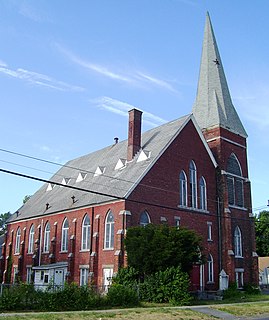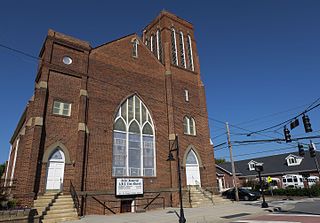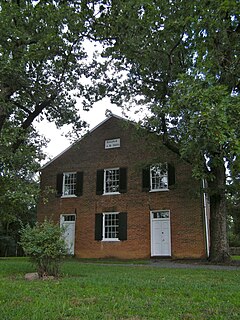
The Mount Zion AME Church is a historic church in Jacksonville, Florida, United States. It is located at 201 East Beaver Street. On December 30, 1992, it was added to the U.S. National Register of Historic Places. The "AME" is an abbreviation of African Methodist Episcopal, the religious denomination.

The John Street United Methodist Church – also known as Old John Street Methodist Episcopal Church – located at 44 John Street between Nassau and William Streets in the Financial District of Manhattan, New York City was built in 1841 in the Georgian style, with the design attributed to William Hurry and/or Philip Embury. The congregation is the oldest Methodist congregation in North America, founded on October 12, 1766 as the Wesleyan Society in America.

Zion Episcopal Church is a historic Episcopal church in Palmyra, Wayne County, New York. It was designed in a Late Gothic Revival style by Emlyn T. Littel and was built in 1872. It is built of Medina sandstone with limestone trim. Its roof features polychrome slate shingles.

German Evangelical Lutheran Church of St. Mark is a historic church and synagogue building at 323 East 6th Street between First and Second Avenues in the East Village neighborhood of Manhattan, New York City. The Renaissance Revival style church was built in 1847 by the Evangelical Lutheran Church of St. Matthew which first rented it to St. Mark's and subsequently sold it to them in 1857. Much of the church membership was killed in the 1904 General Slocum disaster, and the congregation never recovered.

St. Augustine's Church at 290 Henry Street between Montgomery and Jackson Streets on the Lower East Side of Manhattan, New York City.

The Church of the Immaculate Conception and Clergy House at 406-412 East 14th Street between First Avenue and Avenue A in the East Village neighborhood of Manhattan, New York City were built in 1894-96 by Grace Church, one of the most prominent Episcopal churches in the city at the time. The buildings were a free chapel – meaning there was no pew rent – called Grace Chapel and a connected Grace Hospital, which could serve 16 senior citizens and 10 children, and was physically connected to the chapel by a bridge, so that patients could be wheeled to services.

The Metropolitan Baptist Church, located at 151 West 128th Street on the corner of Adam Clayton Powell Jr. Boulevard in the Harlem neighborhood of Manhattan, New York City, was originally built in two sections for the New York Presbyterian Church, which moved to the new building from 167 West 111th Street. The chapel and lecture room were built in 1884-85 and were designed by John Rochester Thomas, while the main sanctuary was constructed in 1889-90 and was designed by Richard R. Davis, perhaps following Thomas's unused design. A planned corner tower was never built.

Wall Street Methodist Episcopal Church, now the home of the African Methodist Episcopal Zion Church, is a historic Methodist Episcopal church located at 69 Wall Street in Auburn, New York, United States. It is a large Gothic Revival style brick and limestone structure built in 1788, and renovated in the 1887. The facade is dominated by a square tower topped by a broach spire. It is an example of an auditorium plan church, popular in church design from the 1880s to 1920s.

St. James AME Zion Church is a historic African Methodist Episcopal Zion church located at Ithaca in Tompkins County, New York. It is a two-story, frame church structure set on a high foundation and featuring a four-story entrance tower. The church structure was begun in the 1830s and modified many times since. The original stone meetinghouse was built in 1836 and is believed to be Ithaca's oldest church and one of the oldest in the AME Zion system.

Thomas Memorial AME Zion Church is a historic African Methodist Episcopal Zion church located at Watertown in Jefferson County, New York. It was built in 1909 and is a small front gabled vernacular building with minimal Gothic details. It is constructed of cast concrete blocks and features a plain square tower with no spire. Its also a place where the run away slaves would use as a hub for the under ground railroad, along with several houses on the street. It was listed on the National Register of Historic Places in 2002.

Zion Episcopal Church and Rectory is a historic Episcopal church complex located at Colton in St. Lawrence County, New York. The church was built in 1883 of red Potsdam Sandstone. It is a gable front building, approximately 48 feet (15 m) wide and 80 feet (24 m) deep and features an 85-foot-tall (26 m), 14+1⁄2-foot-square (4.4 m) tower. The rectory was built about 1900 and is a two-story, clapboard-sided Italianate building on a sandstone foundation. It is now used as the Colton Town Museum. Also on the property is a cast-iron urn a cast-iron lamppost dating to the 1880s.

St. John's Lutheran Church, also known as Zion St. John's Lutheran Church, is a historic Lutheran church in Beekman Corners in Schoharie County, New York. It is a rectangular, gable roofed, timber framed structure with narrow clapboard siding in the vernacular Greek Revival style. It was built in 1860 and features an open belfry with plan Tuscan columns that surmount the staged bell tower above the roof ridgeline. It was listed on the National Register of Historic Places in 2008.

Zion Episcopal Church Complex and Harmony Cemetery is a national historic district comprising a historic Episcopal church complex and cemetery located at Morris in Otsego County, New York. The complex consists of the church, rectory (1893), and parish house (1901). The church was built in 1818 and is a stone building in the early English Gothic Revival style. It features a steeply sloping gable roof and a central projecting bell tower with a belfry with a balustrade. The Harmony Cemetery has burials dating from about 1800 to 1937.

St. Peter's AME Zion Church is a historic African Methodist Episcopal church located at 615 Queen Street in New Bern, Craven County, North Carolina. It was built between 1923 and 1942, on the site of the 1914 church building which was destroyed by fire in 1922. It is a large three bay by seven bay, rectangular brick church building in the Late Gothic Revival style. It features a gabled nave flanked by two-story truncated stair towers. Also on the property is the contributing 1926 parsonage; a 2 1/2-story, frame American Craftsman style dwelling. It is known within the denomination as the "Mother Church of Zion Methodism in the South," and the oldest existing African Methodist Episcopal congregation in the South.

Goler Memorial African Methodist Episcopal Zion Church, also known as Old Goler, is a historic African Methodist Episcopal Zion church located at 630 Patterson Avenue in Winston-Salem, Forsyth County, North Carolina. It was built in 1918–1919, and is a rectangular brick building in the Late Gothic Revival style. It features a gable-front block flanked by two square brick towers and stained glass windows. A two-story annex was built in 1946. In 1942, the Goler Metropolitan AME Zion Church congregation split from the Goler Memorial African Methodist Episcopal Zion Church.

Grace A.M.E. Zion Church is a historic African Methodist Episcopal Zion church located in what was once the Brooklyn neighborhood of Charlotte, Mecklenburg County, North Carolina. It was built in 1901–1902, and is a Gothic Revival style brick church. The front facade features two crenellated entry towers of unequal height with matching Gothic arched entrances. It is one of the oldest of the remaining African American churches associated with Charlotte's historic black districts.

Douglaston Hill Historic District is a national historic district in Douglaston, Queens, New York. It includes 83 contributing buildings and two contributing sites. The buildings include Zion Episcopal Church (1830), houses and garages, and commercial buildings. The sites are Zion cemetery and public park. It was laid out with very large lots in 1853, at the very beginning of a movement in the United States to create suburban gardens. The buildings include a number of fine examples of late-19th- and early 20th-century architectural styles such as Queen Anne, Shingle Style, and Colonial Revival. The majority of the buildings date between 1890 and 1940.

Zion Lutheran Church, also known as the Zion Church of the City of Baltimore, is a historic Evangelical Lutheran church located in downtown Baltimore, Maryland, United States, founded 1755.

Mount Zion Old School Baptist Church, also known as Mount Zion Primitive Baptist Church and Mount Zion Old School Predestinarian Baptist Church, is a historic Primitive Baptist church located at Gilberts Corner, Loudoun County, Virginia. It is now maintained by the Northern Virginia Regional Park Authority: the property including the adjoining cemetery is open from dawn to dusk and the church itself open on the fourth Sunday of various months, or by reservation for weddings and events.

People's African Methodist Episcopal Zion Church is a historic African Methodist Episcopal Zion church located in Downtown Syracuse, Onondaga County, New York. It was designed by architect Charles Erastus Colton and Wallace Rayfield and built in 1911. It is a small Gothic Revival style stuccoed brick building. It sits on a cut limestone foundation and measures approximately 25 feet wide and 50 feet deep. It has a two-story projecting front gable and features a three-story bell tower topped by a pyramidal roof. The congregation was incorporated in 1837 and remained at this location until 1976.























